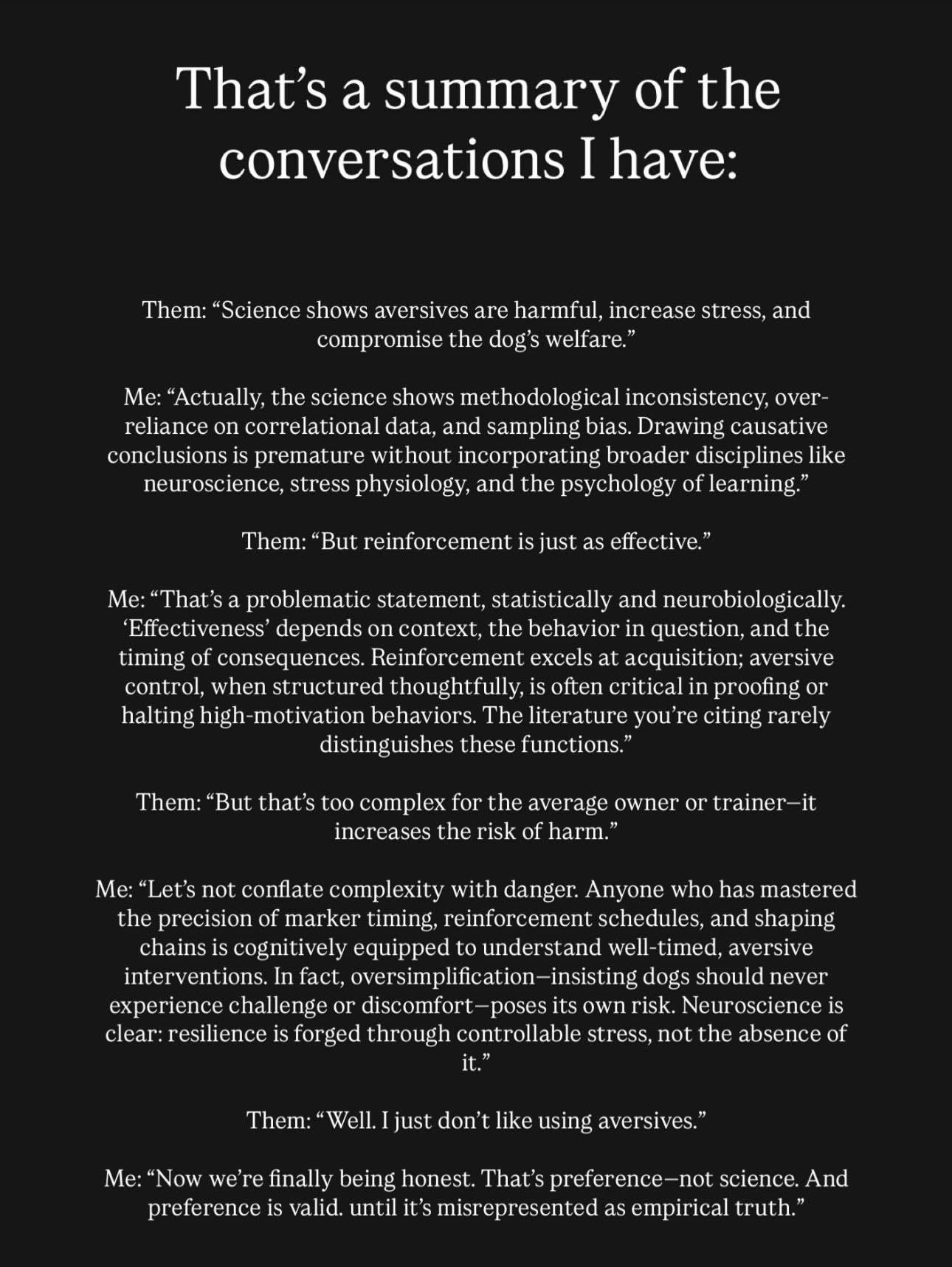Lessons from the Leash (Chapter 5): The Battle of the Tools
The dog needed clarity. The human needed permission.

He was a strong dog, physically and mentally. A two-year-old working breed mix, all muscle and momentum. Smart. Sensitive. Always thinking one step ahead. We’ll call him Bowie to maintain the family’s privacy.
His owner, ‘Alana’, was equally strong-willed. She loved Bowie fiercely and had put in months of work. They’d tried harnesses, flat collars, food-based training, and group classes. She had watched every “positive-only” video on YouTube, followed accounts that warned against “aversive tools,” and had been told by friends and trainers alike that anything beyond a treat pouch was cruel.
After several sessions, Alana made real progress; her handling skills were sharper, her engagement stronger, and her management more consistent. But despite these gains, Bowie’s issues with pulling, lunging, barking, and general reactivity persisted. Alana was overwhelmed. Her friends had stopped coming over. More than once, she confessed she considered giving up on him altogether. That’s when I gently introduced the idea of expanding our toolkit, suggesting options like a prong collar or e-collar to support the work we were already doing. The moment I mentioned it, I saw it, she bristled. Walls went up.
She didn’t say no. But I saw it in her eyes. The hesitation. The fear. The internal conflict between what she thought she believed and what her dog needed.
The Story
Bowie was pulling Alana down the street. Not in a reactive way, just determined, driven, disconnected. He blew through thresholds, ignored leash pressure, and couldn’t focus for more than a few seconds outside the house. Alana’s arm was sore. Her back hurt. Walks were becoming a battle, and still, she clung to the hope that eventually food and repetition alone would get them there.
I understood. I’ve been there.
She wasn’t lazy. She wasn’t naive. She just didn’t want to hurt him. And in her mind, using a tool felt like giving up on trust.
But here’s what I’ve learned: the right tool, in the right hands, with the right intent, isn’t about punishment. It’s about communication.
So we talked. I explained how pressure works. How dogs already understand it intuitively, from their littermates, from movement, from life. I showed her how the prong collar distributes pressure evenly, how soft it could be when used fairly. I let her try it on me and eventually on her arm. I demonstrated a short walking session with the collar on my neck, helping her understand leash pressure. From there, we worked with Bowie, slowly conditioning the prong and showing her how quickly he tuned in.
He wasn’t shut down. He wasn’t scared. He was relieved.
For the first time, the leash made sense.
Alana didn’t cry, but her shoulders dropped. The tension left her voice. She whispered, “Oh… he gets it.”
From that day forward, we trained with clarity, not because the tool magically fixed everything, but because it gave us a common language. One she could use consistently. One he could understand.
Source: Dr. Melanie Uhde
Training Lesson: Tools Are Neutral, Intent Is Everything
Prong collars. E-collars. Slip leads. Treats. Toys. Food. Even your voice and your hands are all just tools.
None of them are good or bad on their own. They become helpful or harmful based on how they’re used.
A leash can guide or restrict. A treat can teach or bribe. A tool can communicate or confuse.
When we remove ego from the conversation, we stop asking, “What does this tool say about me?” and start asking, “What does this tool allow me to say to my dog?”
That’s what matters.
Because in the end, tools don’t create results. Clarity, timing, and follow-through do.
Take-Home Homework: Try It First, Judge It Later
If there’s a tool you’ve been resisting, slip lead, prong collar, e-collar, long line, or even structured crate time, ask yourself why.
Then do this:
Try it on yourself. Feel the pressure. Understand how it works.
Watch someone skilled use it properly with a dog. Look at the body language. Does the dog look afraid, or focused and engaged?
Test it in a low-distraction setting with guidance. Watch how your dog responds. Are they confused, or relieved?
Clarity often lives on the other side of hesitation.
Reflection: Sometimes We Resist What’s Best for Us
It’s easy to confuse discomfort with danger. To assume that anything unfamiliar is harmful. But some of the most transformative tools in life, and in training, first appear as things we want to avoid.
Why?
Because they challenge our identity. They confront our pride. They threaten the beliefs we’ve wrapped ourselves in.
But sometimes, what we resist the most is what we need the most.
Alana didn’t just learn how to use a prong collar. She learned how to let go of the story that said “kindness means never applying pressure.”
She learned that clarity is kindness. And sometimes, controlled pressure is the path to peace.
Happy training,
– Karl MacPhee
IDTP, CPCC, PCC
FireTeam K9 Trainer/Coach
Edmonton, Alberta, Canada





